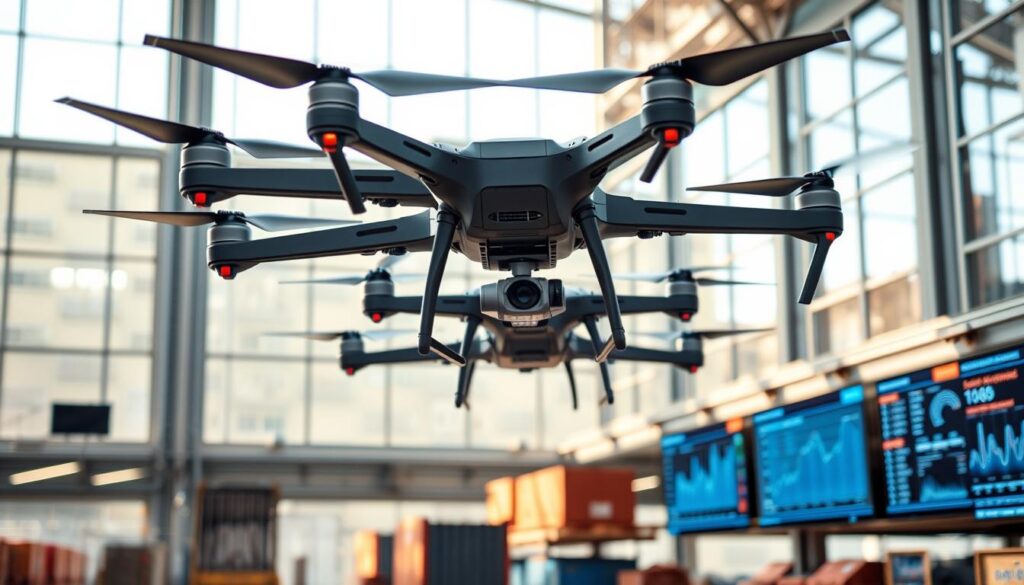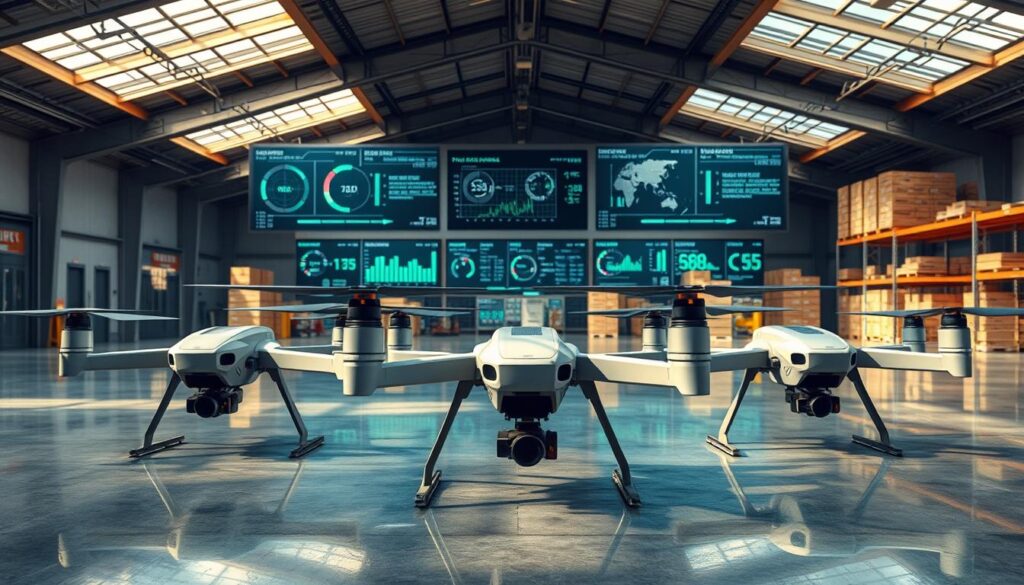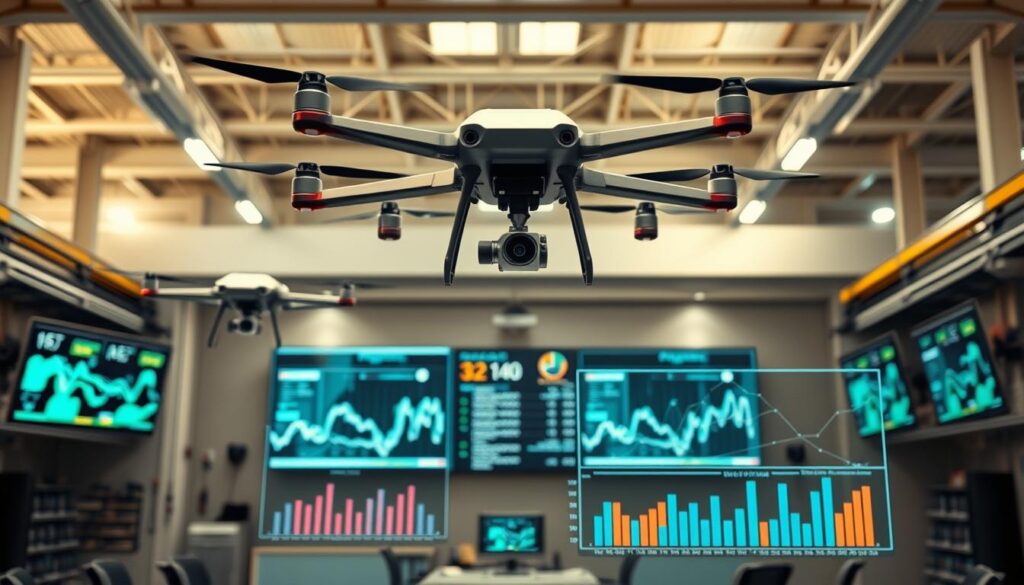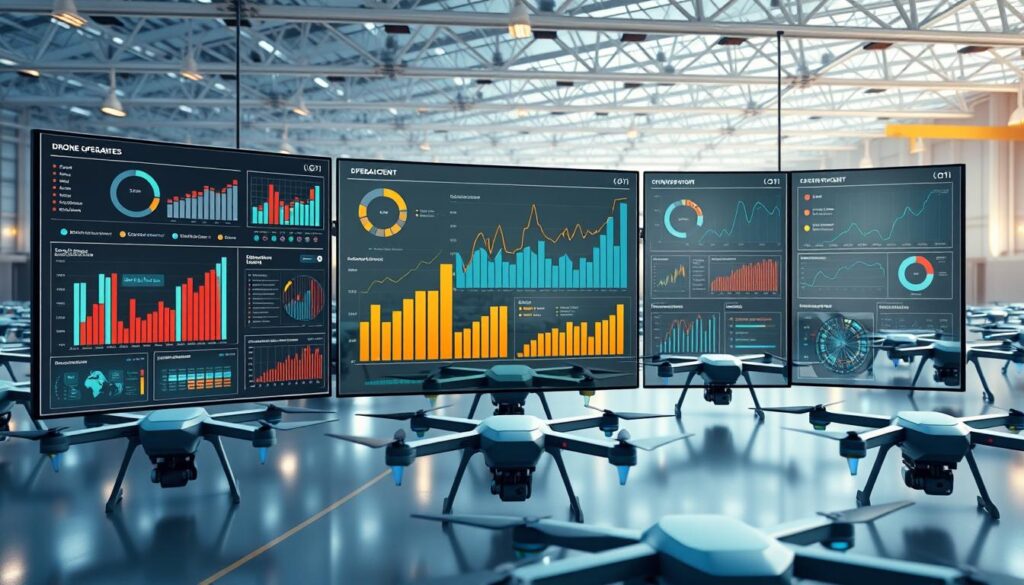One morning a regional hub faced a surprise outage: a key delivery run stalled when several units reported low power and a navigation glitch. The team switched to a new monitoring approach that combined on-board processing with cloud analytics. Within weeks they cut downtime and kept schedules on track.
![]()
This Best Practices Guide helps U.S. logistics leaders compare top solutions for AI drone fleet tracking and align toolsets with business goals. Expect guidance on reducing downtime with proactive checks, boosting route efficiency with analytics, and extending battery life through smarter charging cycles.
Iottive brings end-to-end integration skills in BLE, mobile apps, and custom IoT platforms to help teams deploy resilient platforms. The guide covers vendor fit, API interoperability, compliance basics, and ROI levers that raise reliability and cut costs.
Key Takeaways
- Match systems to use cases like yard mapping or hub-to-hub delivery.
- Use on-board processing plus cloud analytics to turn raw data into action.
- Prioritize interoperability: APIs, SDKs, and BLE telemetry matter.
- Proactive maintenance and predictive alerts reduce downtime.
- Assess vendors for WMS/TMS integration and regulatory support.
Why smarter drone fleet monitoring matters now for U.S. logistics
Rising parcel volumes and congested yards demand smarter aerial oversight across U.S. supply chains. Short staffing and tighter windows make timely visibility essential for last-mile and middle-mile success.
Modern systems turn raw data into operational intelligence. Integrating artificial intelligence enables automated mission planning, predictive maintenance, and compliance reporting as flights scale. That reduces aborted missions and improves throughput.
- Faster site mapping and inventory checks cut manual walk rounds.
- Continuous geo-awareness supports U.S. airspace compliance.
- Telemetry from batteries and motors enables proactive maintenance.
- Unified dashboards standardize alerts across multiple drone models.
| Operational Need | Business Benefit | How Iottive Helps |
|---|---|---|
| Real-time visibility | Faster exception handling | Connects drones, edge devices, and mobile apps |
| Predictive maintenance | Less unexpected downtime | Telemetry integration and analytics |
| Compliance & geo-awareness | Safer scale-up in U.S. airspace | Digitally logged reports and secure integrations |
For rapid deployments and U.S. compliance support, contact Iottive at www.iottive.com | sales@iottive.com.
Search intent and what you’ll learn in this Best Practices Guide
Logistics teams are asking for a pragmatic guide to match airborne systems to real operational goals. This section sets clear search intent: readers want unbiased evaluation criteria, concrete platform capabilities, and a step-by-step roadmap for practical adoption.
Iottive supports discovery workshops to define requirements and success metrics before platform selection. Use those workshops to assess needs, pick appropriate technology, and set training and compliance plans.
Effective adoption follows a simple flow: assess requirements, pilot selected systems, train staff, ensure regulatory readiness, and monitor live operations. The guide operationalizes each step so teams can reduce incident rates, increase mission success, and streamline reporting.
- Outcomes: fewer incidents, higher mission success, standardized reporting.
- Audience: operations directors, safety managers, innovation leads, and IT/OT architects.
- Framework: evaluation criteria, data architecture, security, cost modeling, and KPIs.
Templates, vendor checklists, and phased timelines help turn technical concepts—computer vision, machine learning, and NLP—into real applications like yard scans, asset tracking, and automated inspections.
Key advantages and must-have capabilities for intelligent fleet management
Combining edge processing with cloud dashboards turns telemetry into clear operational decisions. That mix drives measurable gains: higher mission success, lower manual oversight, faster incident response, and better SLA performance.
- Core benefits: increased uptime, reduced labor for routine checks, quicker incident detection, and improved SLA adherence.
- Must-have capabilities: automated mission planning, real-time telemetry dashboards, predictive maintenance, and geo-fenced compliance checks.
- Interoperability: support mixed models and payloads, expose standardized APIs/SDKs, and provide a mobile UX for field operators and supervisors.
- Analytics essentials: anomaly detection on telemetry streams, trend analysis for battery life, and utilization insights by site and mission type.
- Safety & resilience: obstacle avoidance, lost-link handling, return-to-home logic, edge intelligence for degraded connectivity, and automated incident logs for audits.
| Capability | Business Benefit | How Iottive Helps |
|---|---|---|
| Telemetry dashboards | Faster decisions | BLE telematics + mobile apps |
| Predictive maintenance | Lower downtime | Analytics pipelines and alerts |
| Interoperability | Scale across sites | APIs, SDKs, plugin architecture |
Well-architected systems combine data, intelligence, and process to scale operations safely and cost-effectively.
Evaluation criteria for the top 5 drone fleet monitoring systems
A clear scoring rubric helps teams compare perception, automation, and compliance features side by side.
Perception and intelligent control
Evaluate embedded computer vision for obstacle avoidance and inspection. Check model update workflows, latency, and support for natural-language tasking.
Operational automation and reliability
Look for dynamic route optimization, automated re-tasking, and coordinated multi-unit operations. Verify battery analytics, motor vibration trends, and edge decision-making during loss of connectivity.
Compliance, security, and scale
Confirm automated flight logging, airspace awareness layers, and configurable FAA-ready reports. Inspect encryption at rest and in transit, role-based access, and secure device onboarding.
| Criteria | What to test | Why it matters |
|---|---|---|
| Perception | Computer vision accuracy, model updates | Safer missions and better inspections |
| Automation | Route optimization, task allocation | Faster ops and lower manual load |
| Security & compliance | Encryption, logging, FAA reports | Regulatory readiness and trusted data |
| Scalability | Telemetry throughput, concurrency tests | Reliable performance at scale |
Iottive assists with technical due diligence, proof-of-concept validation, and system integration to de-risk selection and speed deployment.
Top 5 systems for AI-powered drone fleet management in logistics
Top commercial platforms combine real-time planning engines with deep telemetry streams to keep operations predictable. Modern solutions automate mission planning, forecast maintenance from sensor data, and produce compliance reports. Global flights hit 19.5 million in 2024, making scalable systems essential.
Platform A
Strengths: rapid mission planning that ingests terrain, weather, and no-fly zones to produce safe routes at scale.
Platform B
Strengths: deep predictive maintenance with battery cycle analytics, motor current anomaly detection, and environmental stress metrics.
Platform C
Strengths: advanced computer vision for inspections, high defect-detection accuracy, and on-device processing for low latency.
Platform D
Strengths: compliance workflows with automated logs, configurable checklists, and live air traffic overlays for risk reduction.
Platform E
Strengths: open ecosystem with APIs, SDKs, webhooks, and connectors to cloud analytics and mobile workforce tools. Iottive can integrate selected platforms with BLE telemetry and existing apps to speed adoption.
“Compare planning engines by how they ingest terrain, weather, and no-fly data to generate safe, efficient missions at scale.”
| Platform | Core strength | Why it matters |
|---|---|---|
| Platform A | Real-time planning | Better mission success and scheduling |
| Platform B | Predictive maintenance | Lower downtime and costs |
| Platform C | Computer vision | Faster inspections with accuracy |
| Platform D | Compliance | Reduced regulatory risk |
| Platform E | Open integrations | Easier enterprise adoption |
AI technologies transforming fleet monitoring
Modern perception and prediction tools turn sensor streams into clear guidance for operators. These tools combine vision, models, and natural‑language interfaces to speed decisions on site.

Computer vision for obstacle avoidance and inspection
CNN-based perception recognizes objects and hazards in real time. That reduces collisions and finds infrastructure defects during routine runs.
Machine learning for routes and maintenance
Machine learning optimizes routes using energy, weather, and timing constraints. Predictive models forecast battery and component failures so teams service units before incidents occur.
NLP for tasking and accessibility
Natural-language interfaces let operators assign missions and request status without complex menus. This lowers training time and speeds frontline response.
| Capability | Benefit | Implementation note |
|---|---|---|
| Vision (CNN) | Real-time hazard detection | Edge inference for low latency |
| Predictive models | Fewer unexpected failures | Requires labeled data and retraining |
| NLP tasking | Faster mission assignment | Governance for ambiguous commands |
Integration: feed model outputs into dashboards, alerts, and automated workflows. Iottive operationalizes these capabilities through AIoT solutions and mobile interfaces, closing the loop with continuous retraining and strict version control before wide release.
AI drone fleet tracking, IoT drone health monitoring, autonomous logistics drone
Real‑time telemetry and smart sensors give operations teams a single source of truth for every mission.
Define end‑to‑end tracking as location, status, payload, and component metrics combined into one live view. This unified picture speeds decisions and reduces confusion for operators in yard and hub environments.
Use BLE and internet things sensors to capture battery cycles, motor current, and payload bay status. Early anomaly detection flags unusual temperature or draw patterns so teams can act before failures occur.
- Automated tasks: recurring yard scans, inventory checks, and scheduled inspections with minimal human input.
- Proactive alerts: thresholds based on cycle counts and temperature that trigger service workflows.
- Data flows: edge → cloud analytics → operator apps with role‑based views and secure onboarding.
Business outcomes include fewer canceled missions, longer component life, and tighter schedule adherence. Integration with maintenance management systems can auto‑create work orders when thresholds are breached.
| KPI | What to measure | Target |
|---|---|---|
| MTBF | Mean time between failures | Increase year‑over‑year |
| Battery cycle utilization | Charge/discharge patterns | Optimize to extend life |
| Predictive vs reactive | Maintenance ratio | Higher predictive percentage |
Train operators to read dashboards and act on alerts. Clear roles and simple workflows ensure measured data drives faster, safer maintenance and better operational management.
Implementation roadmap: from pilot to scaled autonomous operations
Begin with a focused pilot to prove data quality and operational value before broad rollouts. Start small so teams can see quick wins and build confidence.

Phased rollout: start with flight logging and analytics, then automate missions
Launch a narrow pilot that captures automated flight logs, baseline analytics, and simple dashboards. Use those results to validate telemetry reliability and safety cases.
Training and change management to overcome resistance
Train operators and supervisors with hands-on sessions and role-based guides. Appoint local change champions to share learning and speed adoption.
Continuous monitoring and iteration for safety and efficiency gains
Implement alert tuning, model performance tracking, and incident postmortems. Define governance for roles, access, and sign-off on new behaviors.
“Start with verifiable data, then scale automation only after safety and integration are proven.”
- Integrations: sync mission records with compliance and maintenance systems for quick wins.
- Security: encrypted data flows, secure identities, and regular key rotation.
- Scale planning: forecast telemetry throughput, storage, and API capacity.
Iottive supports pilots, integrations, operator training, and phased automation with managed services to lower risk and speed value.
Data architecture for real-time telemetry, analytics, and digital twins
A robust data backbone ties live telemetry to predictive models and digital twins for faster, safer operations.
Start by declaring telemetry streams: GNSS, IMU, video, and battery metrics. Normalize these streams into time-aligned records for control loops and analytics.
Edge processing versus cloud pipelines
Edge handles latency-sensitive tasks like obstacle avoidance and short-term guidance. That keeps critical decisions local when connectivity drops.
Cloud hosts heavy analytics, model training, compliance reporting, and fleet-wide insights. It also archives raw data for audits and retraining.
“Place instant intelligence at the edge, then use cloud scale to refine models and maintain audit trails.”
- Digital twins represent hubs, routes, and missions to simulate throughput impacts.
- Data lifecycle: ingestion → storage → feature extraction → model scoring → dashboards → archival.
- Reliability: buffer during outages, apply back-pressure, and enable replay for consistency.
| Topic | Design Note | Business Value |
|---|---|---|
| Telemetry normalization | Timestamp, schema, metadata | Accurate analytics and control |
| MLOps | Model registry, canary rollouts, drift detection | Safe, repeatable updates |
| Observability | Metrics, logs, traces | Rapid anomaly detection |
Iottive architects cloud and mobile integrations plus edge pipelines to sync data with digital twins and operational apps. Strong privacy controls, schema standards, and closed-loop integrations with maintenance and enterprise systems complete the picture.
Scaling operations: coordinating multiple drones like autonomous air traffic

Coordinating multiple drones across busy yards works like managing small airports. Cloud and edge orchestration schedule missions and prevent conflicts. Iottive links orchestration to mobile apps so field teams see live status.
Orchestration schedules concurrent missions with conflict-free routing. Dynamic tasking reassigns missions by battery, weather, and route load in real time. Collision avoidance follows separation standards that mirror air traffic principles.
Shared situational awareness gives supervisors live maps, overlays, and health indicators. Throughput improves with queueing, priority rules, and automation guardrails. Human-on-the-loop oversight handles safety-critical calls.
| Focus | What it delivers | Why it matters |
|---|---|---|
| Scheduling & routing | Conflict-free missions | Higher asset utilization |
| Real-time tasking | Dynamic reassignment | Faster anomaly response |
| Shared maps & status | Supervisor visibility | Consistent execution |
| Data & compliance | Reliable telemetry and logs | Audit-ready reports |
Test at increasing scale to validate resilience under peak loads. Robust data—accurate geofencing and low-latency telemetry—enables safe management and reliable automation. The result: steady operations, faster responses, and repeatable performance across sites for any drone fleet.
Security, privacy, and regulatory compliance in the United States
Data protection, access controls, and strict device hygiene form the backbone of safe operations. Platforms must embed technical controls and mapped workflows so teams can prove compliance during audits.
Data encryption, access control, and secure device management
Encrypt telemetry and media in transit and at rest. Use TLS for streams, AES-256 for storage, and regular key rotation aligned to enterprise policy.
Limit access with least-privilege roles, multi-factor authentication, and complete audit logs for operator and admin actions. Iottive implements RBAC and secure onboarding to enforce these rules.
FAA rules, airspace constraints, and automated compliance
Map FAA workflows into software: automated pre-flight checks, geofence enforcement, and instant incident reports. Systems can export audit-ready logs and flag potential violations to operators in real time.
Risk management for crowded airspace and BVLOS operations
Address BVLOS with detect-and-avoid, redundant comms, and documented safety cases. Model crowded airspace risks and enable dynamic rerouting to preserve safe separation from other air traffic.
| Control | Benefit | Iottive Implementation |
|---|---|---|
| Encryption & key rotation | Protects telemetry and media | TLS streams, AES-256 storage, scheduled key rotation |
| Access & audit | Accountability and least privilege | RBAC, MFA, full operator/admin logs |
| Device lifecycle | Trusted devices and patching | Identity provisioning, firmware signing, OTA updates |
| Regulatory workflows | Faster audits, fewer violations | Pre-flight checks, geofence enforcement, automated reports |
Culture matters: combine vendor risk assessments, pen tests, and periodic reviews with privacy-by-design for minimal PII capture. This steady governance sustains scale and public trust.
Cost modeling and ROI: from capex to ongoing fleet efficiency
A clear cost model turns technical choices into measurable business outcomes for operations teams.

Start by separating capital expenses from ongoing operating costs. List aircraft, payloads, spares, and initial software licenses as capex. Put subscriptions, cloud storage, and support under opex.
Line-item cost areas
Hardware & software: purchase, payloads, subscriptions, and cloud. Include integration fees for WMS/TMS/ERP connectors.
People & training: certification, operator training, and change management to sustain safe operations.
Maintenance & compliance: spares, scheduled servicing, and regulatory filing or certification fees.
Value levers and ROI timing
Quantify gains from fewer manual inspections, faster incident response, and better maintenance schedules. Include risk-adjusted savings from fewer incidents and potential insurance reductions.
Rollout tip: show early wins from analytics and automated logging before full autonomy to shorten payback.
| Cost Category | Example | Business Impact |
|---|---|---|
| Capex | Aircraft, payloads, spares | One-time asset investment |
| Opex | Software subs, cloud, support | Recurring operational spend |
| Integration & services | WMS/TMS/ERP, custom dev | Reduced time-to-value, unified alerts |
| Compliance & training | Certs, audits, training budgets | Lower regulatory risk, safer ops |
- Model sensitivity to mission volume, flight duration, and battery lifecycle to estimate cost per mission.
- Plan marginal cost per additional site as orchestration matures to see scale economics.
- Watch hidden costs: data egress, manual data wrangling, and fragmented tooling—these raise TCO fast.
Iottive can estimate integration, development, and managed services costs and map them to clear value drivers so finance and operations agree on ROI timelines.
Industry applications shaping logistics value chains
Cross-industry sensor platforms are reshaping how goods move from field to warehouse. Industries such as agriculture, construction, and energy supply practical use cases that logistics teams can adopt.
In yard operations, common applications include yard mapping, inventory verification, perimeter security, and rapid incident response. These tasks cut manual checks and speed turnarounds.
Precision agriculture adds value through crop monitoring and crop health scans that feed harvest planning and cold‑chain readiness. That same mission output helps plan pickups and reduce spoilage.
Construction use cases bring progress tracking, as‑built comparisons, and hazard detection to staging areas. Energy inspections of lines and substations tie into supply nodes and right‑of‑way corridors.
Advanced sensors—thermal and multispectral—expand detection for safety and asset protection. Mission outputs become usable when they flow into planning, maintenance, and compliance systems.
| Industry | Primary applications | Logistics tie-in |
|---|---|---|
| Agriculture | Crop monitoring, yield prediction | Harvest scheduling, cold‑chain alerts |
| Construction | Site surveys, progress verification | Staging accuracy, fewer reworks |
| Energy | Infrastructure inspections, ROW checks | Safer supply routes, reduced stoppages |
Cross-industry best practices create repeatable models and shared data schemas. Iottive’s cross‑industry experience helps teams reuse intelligence, reduce truck rolls, and show measurable outcomes like fewer stoppages and better resource allocation.
KPI framework for operational excellence in logistics drone fleets
Clear KPIs turn telemetry into actionable steps that keep operations running and risks low.

Build concise dashboards that show uptime, mission success, battery cycles, safety incidents, and SLA adherence in one view. Iottive links mobile and web apps to backend systems so teams see live results and receive automated reports.
Core metrics and how to act on them
- Fleet uptime & mission success: trigger maintenance scheduling when uptime dips.
- Battery cycle utilization: adjust charge policies and reorder spares based on trends.
- Safety incidents & SLA adherence: auto-create tickets and escalate to supervisors.
| KPI | Primary data source | Operational action |
|---|---|---|
| Uptime / mission success | Automated flight logs, telemetry | Rebalance missions; schedule service |
| Battery cycles | Charge/discharge records, maintenance logs | Replace cells; tune charging profiles |
| Incidents & SLA | Exception reports, operator notes | Escalate, retrain staff, update SOPs |
| Leading indicators | Alert response times, operator workload | Optimize staffing and alerts |
“Turn KPIs into routines: measure, act, and feed results back into short improvement sprints.”
Use benchmarking across sites, set thresholds tied to compliance, and automate escalations when metrics drift. Visualize role-specific dashboards for operations, maintenance, and safety teams and close the loop with continuous improvement cycles supported by Iottive.
Future trends: what’s next for intelligent drone operations
The next wave of capability emphasizes on-device intelligence and cooperative mission behavior for real-world scale. Expect systems that push decisioning to the edge, share situational data across units, and tie live state to rich simulations for safer planning.
Edge AI for resilient autonomy without constant connectivity
Edge processing runs perception and short-term control locally, enabling latency-free obstacle avoidance and mission adaptation when links drop. That reduces aborted missions and keeps operations safe in low-connectivity areas.
Iottive can prototype on-device models and deployment pipelines so teams test changes quickly and safely.
Advanced swarming algorithms for multi-drone collaboration
Swarming enables cooperative coverage, dynamic formation changes, and real-time information sharing to maximize efficiency. Modern algorithms use reinforcement learning and consensus logic to adapt formations to changing tasks and environments.
Interoperability standards will be key so mixed vendors can join a shared airspace without friction.
5G, IoT, and digital twins for real-time synchronization and planning
High-bandwidth uplinks raise video and telemetry fidelity for control rooms and analytics systems. Digital twins let teams simulate missions, test policies, and forecast throughput and safety impacts before live runs.
As machine learning models evolve, teams must add governance: validation, explainability, staged rollouts, and strong cybersecurity to protect more distributed intelligence.
“Prototype at scale: validate edge models, test swarm behavior, and run digital twins before broad rollout.”
- Predict convergence with ground robotics and automated facilities for fully synchronized operations.
- Plan talent shifts: tools, MLOps, and security skills will accelerate safe iteration.
- Address cyber risk through zero-trust, signed firmware, and segmented telemetry channels.
Iottive can prototype edge intelligence, swarming telemetry, and digital twin integrations to help U.S. teams test future trends quickly and reduce deployment risk.
Solution selection checklist for logistics leaders
Begin with a clear checklist that ties business goals to technical validation and operator readiness.
Use structured scoring and hands-on proofs to reduce risk and speed value.
- Define business goals, success metrics, and compliance requirements before shortlisting systems.
- Score perception, machine learning, and natural‑language tasking plus predictive maintenance capabilities.
- Evaluate security: encryption, access control, and secure device onboarding practices.
- Test airspace awareness and automated reporting workflows aligned to U.S. rules.
- Verify interoperability: APIs/SDKs, data schemas, and mobile or edge support for your sites.
- Check scalability under concurrent missions and telemetry loads for real operational stress.
- Assess usability for operators and supervisors with role‑based dashboards and alerts.
- Confirm vendor support, documentation, training, and service level agreements.
- Model TCO and ROI with realistic mission volumes and maintenance schedules to show payback.
- Plan a pilot with clear exit criteria and integration milestones to de‑risk rollout.
Iottive offers vendor‑neutral evaluations, integration planning, and POCs to validate fit before commitment. Follow this checklist to turn technical choices into measurable efficiency gains and to meet common operational challenges while keeping teams aligned.
About Iottive: IoT, AIoT, and BLE expertise for end-to-end drone fleet solutions
From device firmware to cloud pipelines, Iottive delivers end-to-end systems that shorten time-to-value for connected devices. We integrate BLE telemetry, gateways, and mobile apps so operators get reliable, actionable data fast.
Iottive combines internet things engineering with secure device management and cloud analytics. Our services include BLE app development, embedded firmware, and scalable backend pipelines that support artificial intelligence model outputs and real-time alerts.
We connect to WMS, TMS, and ERP platforms to enable closed-loop maintenance and automated work orders. That integration reduces manual steps and improves asset management across sites.
| Capability | Benefit | Example implementation |
|---|---|---|
| BLE telemetry & firmware | Reliable local sensing | Low-latency sensor feeds to mobile apps |
| Cloud & MLOps | Continuous model updates | Canary rollouts and drift monitoring |
| Security & onboarding | Trusted devices | Encrypted flows, RBAC, secure provisioning |
| Digital twins & testing | Safe feature rollouts | Simulations and test harnesses for mission validation |
We translate artificial intelligence, computer vision, and NLP into clear operator workflows so frontline teams can act with confidence. Examples include alert prioritization, automated inspections, and an ai-powered drone checklist for pre-flight safety.
We offer training, documentation, and change management to drive adoption. Invite us to run a discovery pilot and roadmap tailored to U.S. requirements.
“Effective integration blends edge processing, cloud analytics, and secure device management to accelerate time-to-value.”
Contact: www.iottive.com | sales@iottive.com
Conclusion
Practical pilots that tie telemetry to business KPIs are the fastest route from proof‑of‑concept to measurable value.
AI-enabled systems for drones deliver clear gains in safety, reliability, and throughput when paired with strong governance. Evaluation should weigh artificial intelligence strength, automation maturity, compliance readiness, security posture, and scalability.
Build on a sound data architecture: edge + cloud pipelines, observability, and digital twins to plan and recover. Institute encryption, access controls, and audit logs as standard practice.
Look to future trends—edge intelligence, swarming, and 5G—to shape roadmaps. Track KPIs and engage experienced integrators to de‑risk adoption and speed outcomes.
Iottive can partner from strategy to scale—connect to discuss goals and an actionable roadmap. www.iottive.com | sales@iottive.com
FAQ
What are the top capabilities to look for in a modern drone fleet monitoring system?
Look for advanced computer vision for obstacle avoidance and inspection, machine learning for route optimization and predictive maintenance, real-time telemetry and analytics, automated mission planning, secure device management, and strong airspace compliance workflows that match FAA rules.
How does predictive maintenance improve operational uptime?
Predictive maintenance uses sensor data and algorithms to forecast failures before they occur. That reduces unplanned downtime, extends battery and component life, lowers repair costs, and improves mission reliability through scheduled servicing based on actual condition rather than fixed intervals.
What role does edge processing play versus cloud analytics?
Edge processing enables low-latency decisions such as collision avoidance and immediate anomaly detection directly on the vehicle. Cloud analytics handle aggregated telemetry, long-term trend analysis, and training of machine learning models. A hybrid architecture balances responsiveness with scalable insights.
How can teams safely scale from pilot projects to multi-vehicle operations?
Adopt a phased rollout: begin with flight logging and basic analytics, validate automated missions in controlled airspace, implement training and change management, then add swarm coordination and BVLOS procedures. Continuous monitoring and incremental automation lower risk and improve outcomes.
What are best practices for compliance and secure data handling in U.S. airspace?
Implement strong encryption, role-based access control, secure provisioning for Internet of Things devices, and audit trails. Keep systems aligned with FAA guidance, file required waivers for BVLOS, and integrate real-time airspace awareness to avoid restricted zones and ensure automated reporting.
Which KPIs matter most for logistics operations using aerial systems?
Prioritize uptime, mission success rate, battery cycle health, time-to-repair, safety incidents, and SLA adherence. These metrics link directly to operational cost, delivery reliability, and customer satisfaction.
How do advanced sensors and computer vision enable new logistics tasks?
High-resolution cameras, thermal imagers, and LIDAR enable precise parcel identification, drop-off verification, infrastructure inspection, and obstacle detection. Computer vision algorithms turn sensor feeds into actionable events like automated landing checks or anomaly flags.
What security risks should organizations mitigate when deploying connected aerial systems?
Address device spoofing, insecure firmware updates, telemetry interception, and unauthorized access. Use secure boot, signed updates, encrypted communications, and continuous vulnerability management to reduce exposure.
How does predictive routing reduce operational costs?
Predictive routing applies machine learning to traffic patterns, wind forecasts, and historical mission data to select energy-efficient paths, reducing flight time and battery consumption while improving on-time performance.
What infrastructure is required for real-time telemetry and digital twin models?
You need low-latency connectivity (edge nodes or 5G where available), scalable cloud storage and processing pipelines, streaming analytics, and a digital twin platform that mirrors live telemetry for simulation, what-if analysis, and planning.
Can natural-language tasking make operations more accessible?
Yes. Natural-language interfaces let operators set missions, request status updates, and create routines using simple commands. This reduces training time and enables non-specialists to manage common tasks safely when paired with strong validation checks.
What cost components should be included in an ROI model?
Include hardware acquisition, software licensing, connectivity, training, maintenance, compliance costs, and expected savings from automation, reduced downtime, and improved delivery efficiency to build a comprehensive ROI estimate.
How do teams ensure multi-vehicle coordination like urban air traffic?
Use centralized traffic management with real-time position sharing, deconfliction algorithms, time-slot scheduling, and redundant communications. Simulate scenarios with digital twins before live deployment to validate safety procedures.
What future trends will most impact logistics operations?
Expect more edge intelligence for resilient autonomy, advanced swarming for collaborative tasks, wider 5G adoption for low-latency links, and richer digital twins for synchronized planning and predictive decision-making.
How should logistics leaders evaluate vendors for an integrated solution?
Assess technical capabilities (vision, learning, automation), security posture, FAA readiness, integration with cloud and mobile ecosystems, total cost of ownership, and vendor experience in real-world logistics deployments.